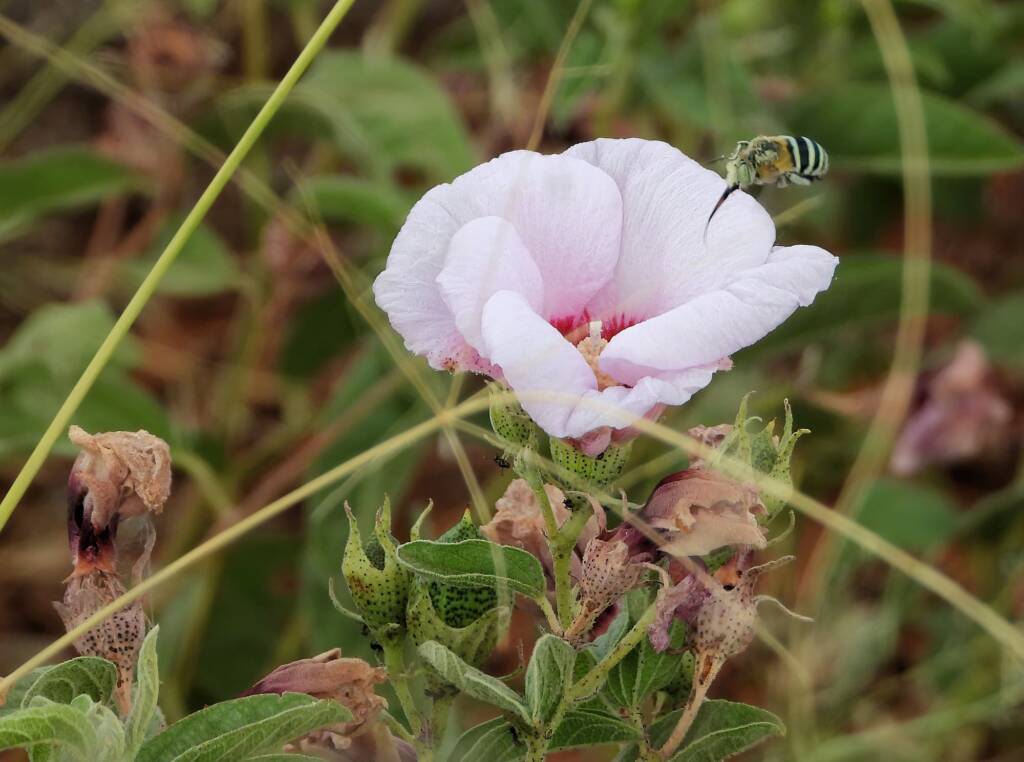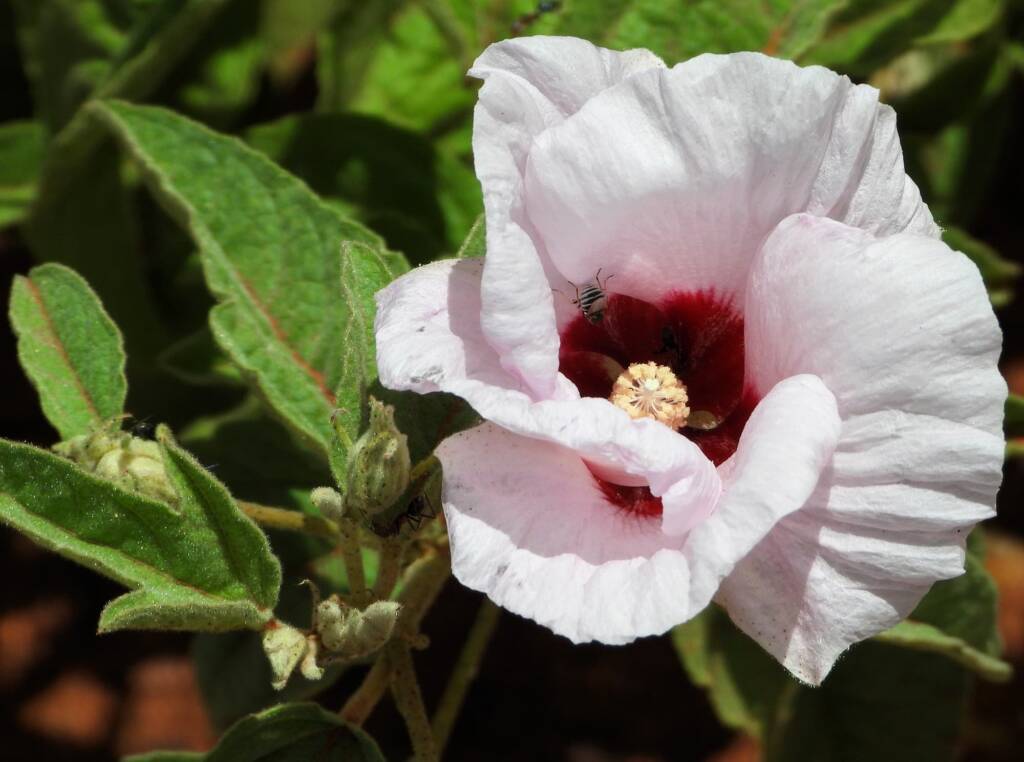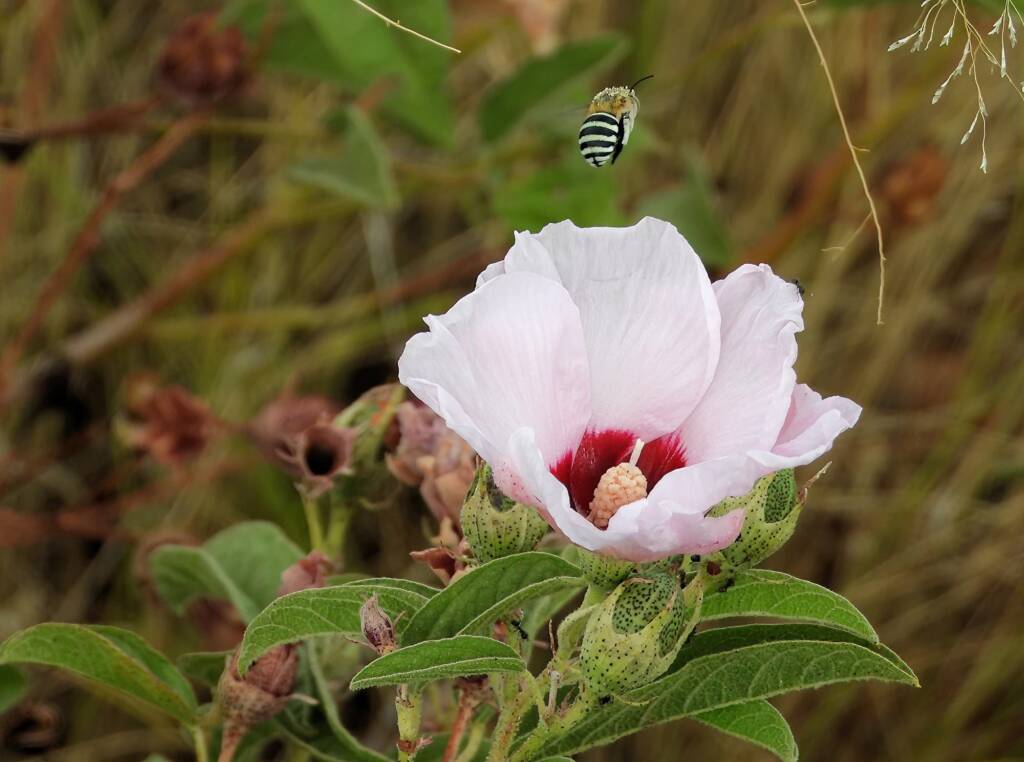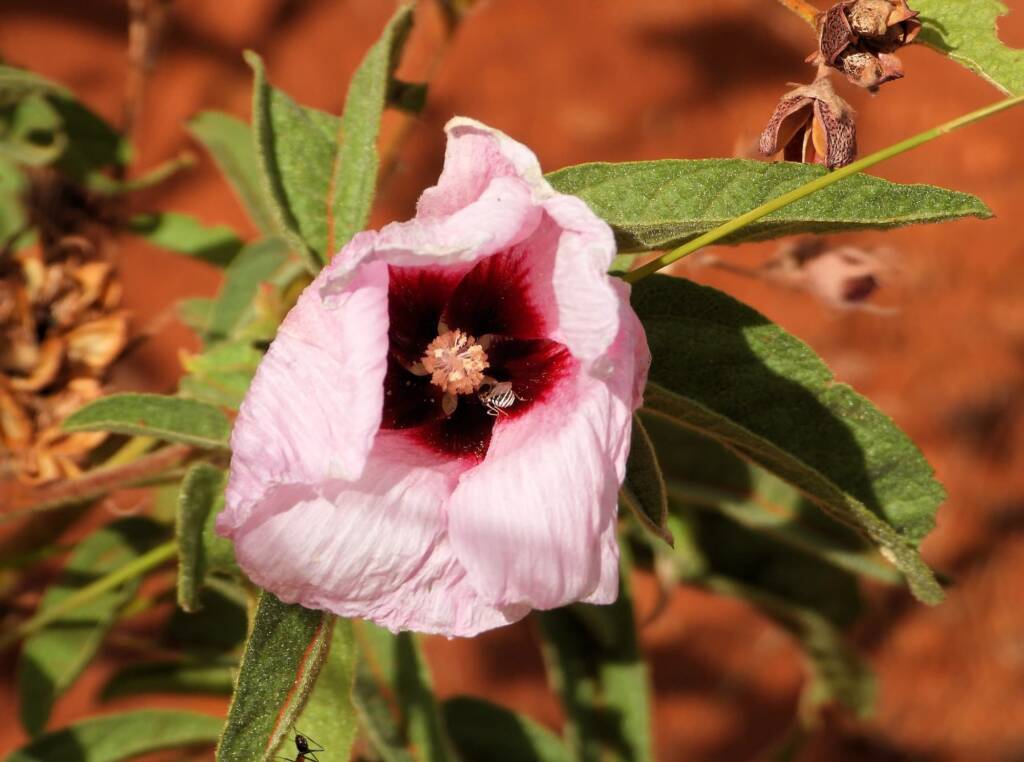Australian GossypiumGossypium australe Gossypium bickii
Gossypium bickii resides in the genus Gossypium, subgenus Sturtia, and one of three species belonging to the section Hibiscoidea. Gossypium bickii together with Gossypium australe, and Gossypium nelsonii belong to the G-genome species.1
A hairy spreading shrub, the leaves are elliptic to ovate, sometimes lobed. The seed capsule is globular and hairless. The calyx has long narrow lobes (the calyx surrounds and protects the growing flower bud. It is composed of one or more leaf-like structures called sepals). The epicalyx is a whorl of bracts, below the calyx.
The flowers are pale pink-mauve colour with a deep red base. They are commonly known as Desert Rose, with Gossypium bickii also commonly known as the Low Desert Rose.
Like most of the Gossypium species, they are a popular flowering plant for native insects. During peak flowering season, the flower can be buzzing with bees, insects and even spiders in search of prey.

Gossypium bickii are often found growing as low / spindly shrubs, up to approximately 50 cm and 1 metre wide. They are found in mulga, open shrublands and grasslands, particularly in Central Australia, from areas south of Alice Springs to the Tanami Desert, lower Barkly Tablelands to just east of Mount Isa.

The Gossypium is the largest genus in the tribe Gossypieae, with 50 Gossypium species and new species being discovered. There are 17 species of Gossypium (see full list in Australian Gossypium scientific classification) indigenous to Australia.
Whilst Gossypium australe is the most widespread of the section Hibiscoidea, Gossypium bickii and Gossypium nelsonii are mostly found in small populations in western Queensland and the Northern Territory (around Central Australia).



- Scientific classification
- Kingdom: Plantae
- Phylum: Charophyta
- Class: Equisetopsida
- Subclass: Magnoliidae
- Superorder: Rosanae
- Order: Malvales
- Family: Malvaceae
- Genus: Gossypium
- Subgenus: Sturtia
- Section: Hibiscoidea
- Gossypium australe
- Gossypium bickii
- Gossypium nelsonii
- Section: Hibiscoidea
- Subgenus: Sturtia
Footnote & References
- Cotton Molecular Genetics, Australian National Botanic Gardens, https://www.anbg.gov.au/cpbr/program/sc/cotton_mole.htm
- Many thanks for ID to Barb Jim Gilfedder, Rebecca Duncum and Kristen Smith, members of the Alice Springs Field Naturalists Club, Facebook group, https://www.facebook.com/groups/1379683398719247
- Species profile—Gossypium bickii, Queensland Government, https://apps.des.qld.gov.au/species-search/details/?id=13922
- Gossypium bickii Occurrence records, AVH The Australasian Virtual Herbarium, https://avh.ala.org.au/occurrences/search?taxa=Gossypium%20bickii#tab_mapView
- Wildflowers & Plants of Inland Australia, by Anne Urban, G bickii p122
FloraFlora in Australia Flora Index Acacia Anigozanthos (Kangaroo Paws) Annual Yellowtop Apium prostratum subsp. prostratum var filiforme Apple Bush (Pterocaulon sphacelatum) Australian Bluebell Australian Gossypium Banksia Batswing Coral Tree Billy Buttons Birdsville Indigo Blue Pincushion Bush Banana Callistemon Callitris drummondii (Drummond’s Cypress Pine) Calothamnus quadrifidus Cape Honeysuckle Cassia fistula (Golden Shower) Cattle Bush Common Heath Crotalaria Darwinia wittwerorum (Wittwer’s Mountain Bell) Daviesia oppositifolia (Rattle-pea) Desert Oaks Drumsticks Eremophila Eucalyptus Ficus Flannel Cudweed (Actinobole uliginosum) Georges Indigo Goatshead Burr (Sclerolaena bicornis) Golden Everlasting Goodenia Gossypium Grass and Grasses Grass Trees Grevillea Grey Germander Hakea Kapok Bush (Aerva javanica) Lambertia sp Leptospermum MacDonnell Ranges Cycad Maireana scleroptera Mexican Poppy Minnie Daisy Mistletoe Family Nardoo Native Apricot Nicotiana megalosiphon subspecies sessilifolia Nuytsia floribunda Orange Spade Flower Orchidaceae Parakeelyas (Calandrinia) Pebble Bush (Stylobasium spathulatum) Perennial Yellow Top Pink Everlasting Pink Rock Wort Poached Egg Daisy Portulaca Proteaceae Ptilotus Quandong Resurrection Fern Rosy Dock Ruby Saltbush Santalum Solanum Spike Centaury Spinifex Storkbill (Erodum cygnorum) Striped Mint Bush Sturt’s Desert Pea Sturt’s Desert Rose Tall Saltbush Tangled Leschenaultia Tar Vine Tribulus eichlerianus Upside-down Plant Urodon dasyphylla Variable Daisy Waratah (Telopea) Wertabona Daisy White Cedar (Melia azedarach) White Indigo White Paper Daisy Wild Passionfruit Wild Stock Woolly-Headed Burr Daisy Woolly Bush Yellow-keeled Swainsona
Flora & FaunaFauna Flora Fauna Flora Funga Glossary Funga Related Topics Scientific Classification Backyard Wildlife Floral Emblems of Australia Wildflowers
